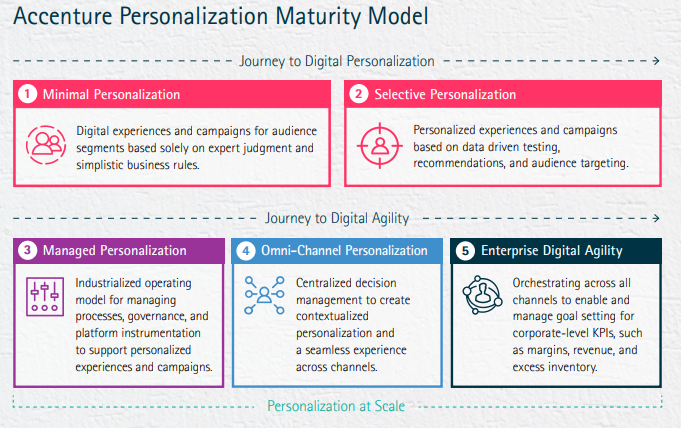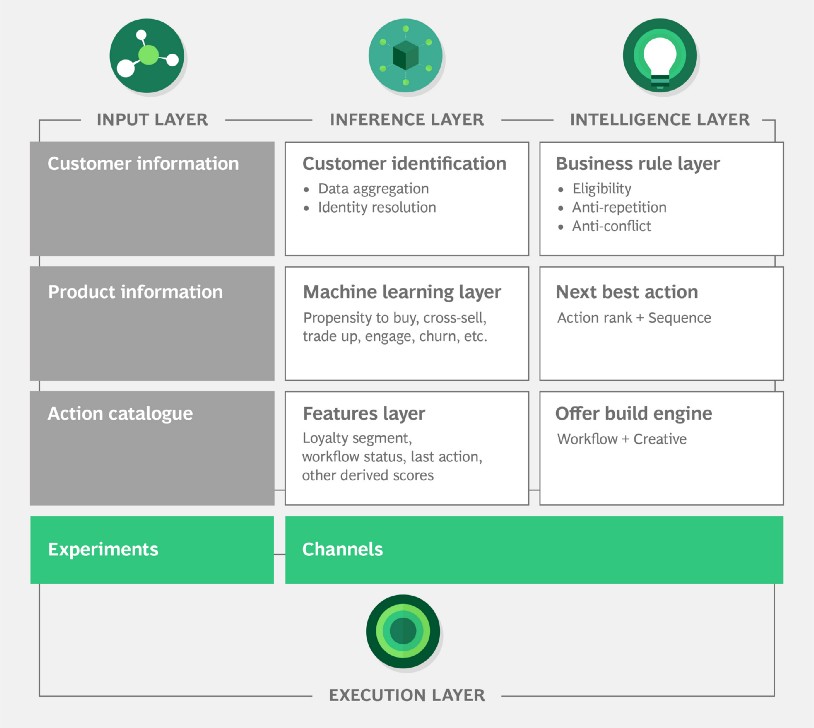For my birthday last month, my friends got my favorite cake from my favorite bakery. But, as soon as we opened the box, all smiles disappeared. A blank cake stared at our faces. There was no message on the cake. The friend who had ordered the cake apologized and called the bakery to yell at them.
“Who likes a non-personalized birthday cake?” she screamed.
I stood there wondering that the cake came for the same price and would taste the same. But the absence of a tiny bit of personalization made all the difference in the experience.
That is how integral personalization is, in customer experience, since always, not just in the digital era.
(By the way, the next week when we needed another cake, we made sure not to buy from that bakery again. The impersonal cake caused the churn!)
Well, we are way past the discussion around “Is personalization important, is it required, and how much does it help…?”
“Personalization is a must” is a strongly-established fact.
In a previous blog, 10 Personalization Challenges: Are You Stuck With Any of These? I had listed the major challenges that most brands face in adopting personalization.
In this one, there are ways suggested to help you navigate through those challenges.
1. Delivering Personalization at Scale
Although businesses know that they can achieve 5-8 times the ROI through personalization, they hold back from adopting it in its full form because of the scalability challenges. They keep themselves limited to personalized emails or product recommendations.
The fact is, there isn’t a single tool yet, that can deliver truly relevant personalized content to millions of customers and prospects across channels, content formats, and touch-points – all automatically.
In one of its reports, Accenture shared a personalization maturity model and mentioned that most brands slow down and mostly stop after stage 2 because of the inability to scale.

Source: Accenture
However, with a planned strategy combined with marketing technology, automation, and advanced analytics techniques, effective personalization at scale is very much achievable now.
What does ‘delivering at scale’ mean?
In simple words, testing a new marketing campaign/strategy with a few customers and replicating successful ideas is delivering ‘at scale’.
To achieve personalization at scale, you need to get the “test and learn” engine running. This needs creating a continuously self-improving learning system that connects insights, execution, and outcomes.
Marrying Data to Decision-making
Most marketers succeed in capturing customer data from all sources. But that is equivalent to getting together all the ingredients required to make a dish. Unless the ingredients are cooked correctly, the taste and aroma of the dish is only an imagination. Churning the data in meaningful ways to get insights about the customers (their preferences, interests, desires, needs, etc.) is the required next step to taste the personalization flavors.
However, given the huge amounts of structured and unstructured data, churning all the data is easier said than done. The traditional CRM systems do not have the capability to give insights or even manage the vast piles of data.
You need a system that can run advanced analytics on the data and discover useful and actionable insights and then trigger appropriate actions. And the newest solution in the market that can achieve this for you is a Customer Data Platform.
As per the CDP Institute;
“A Customer Data Platform is a packaged software that creates a persistent, unified customer database that is accessible to other systems.”
This definition has three critical elements:
– “Packaged software“: The CDP is a pre-built system that is configured to meet the needs of each client. Some technical resources will be required to set up and maintain the CDP, but it does not require a typical data warehouse project’s technical skill. This reduces the time, cost, and risk and gives business users more control over the system, even though they may still need technical assistance.
– “Creates a persistent, unified customer database“: The CDP creates a comprehensive view of each customer by capturing data from multiple systems, linking information related to the same customer, and storing the information to track behavior over time. The CDP contains personal identifiers used to target marketing messages and track individual-level marketing results.
– “Accessible to other systems“: Other systems can use data stored in the CDP for analysis and manage customer interactions.
Find more on CDP here.
Analytics and Automation
The advanced analytics models that generate propensity scores for customers, can be integrated with CDP so that the automated decision-making process becomes a two-way communication. This integration combines the two processes of collecting and tracking customer reactions and using that information to guide future messaging, into one seamless process.
After this, for the continuous execution of personalized marketing campaigns in the right manner, a robust marketing automation platform in place is a must.
Orchestration – the other side of the coin
Imagine yourself sitting in an auditorium. There is a huge ensemble of highly skilled musicians with a variety of instruments. There is no conductor though. As soon as they start playing, all you hear is noise and run towards the exit.
That’s what happens to customers when brands subject them to an experience that is the result of marketing tools working in silos. With so many solutions and platforms working in a disjoint manner without a seamless flow of information from one system to another, there is chaos and confusion for the customers.
Marketing orchestration is a transformative holistic approach towards how marketing synchronizes their teams, content, channels, workflows, and data. So, let marketing orchestration be your guiding principle. Effective orchestration of tools and technologies, data, channels, and teams can focus more on strategizing than wasting energy on operational bottlenecks and technical glitches. If all assets, calendars, campaign status, and performance reports are easily available to the entire team in a centralized place, achieving the personalization goals won’t be as difficult.
2. Enabling Organization-wide Implementation and Adoption
You get all data sorted, tools in place, and ideas in order. But personalization is not a single team’s game. Running a smooth personalization system at scale requires a seamless collaboration of teams across the organization. From C-level executives to technical executioners, you’ll need the right people on your side. And that’s not an easy thing to achieve. Addressing this challenge requires changing how things are done.
Here are some workarounds:
- Define your strategies clearly:
You need to determine the goals you want to achieve out of each personalization tactic and define specific use cases accordingly. You can explain anything only if you know it clearly. Onboarding internal and external resources (e.g., agency and technology partners) would be much easier then.
- Build the perfect team:
First onboard the key C-level executives. Let the Chief Marketing Officer, Chief Technology Officer, Chief Financial Officer understand the whys and what’s of personalization. Align the business objectives with the marketing projects. Buy in the full-fledged support of other business decision-makers like product managers and business analysts. And last but not the least, build a solid group of executioners – content marketers, publishers, asset managers, analytics team, IT, and technical support.
In case you have external agency partners to work with, it is crucial to establish good coordination with them to function as a cohesive unit and to put insights into action at scale.
- Keep the reins in your hands:
Any amount of intelligent automation cannot replace what your years of marketing experience can bring. While implementing automation implies that you can sit back and relax, you have to let your experience do the magic.
Also, if you have agencies who support your campaigns or a dedicated internal team to run the automation system, use your experience in fine-tuning those campaigns. - Stay agile:
Consider the personalization engine as a living entity that needs continuous upkeep and nourishment. For best results, it is important to continuously test business use cases, update the data, tech, and analytics infrastructure from time to time. The marketing technology ecosystem evolves quickly, and hence your systems need to be flexible so that outdated technologies can be replaced with the latest ones easily.
- Focus on fine content:
Content is the soul of personalization, and it needs to be crafted with care and passion. Even if your technology and tools are top-notch, but if your content is stale, robotic, and low-quality, you would not achieve much. So, do not undermine the value of high-quality content generated by skilled designers, copywriters, animators, and videographers. Keep testing all the content attributes regularly to refine the visual appeal, tone, calls to action, and messaging.
Bringing this team together around one shared personalization goal is the key. Once you have your army ready, let the personalization begin!
3. Solving the Segmentation Challenge
You certainly know the term – ‘segment-of-one’. You might ask if all the talk is about delivering a one-to-one unique experience to each user, is dividing the customer base into segments useful or required at all?
But this confusion is rooted in the misconception that personalization and segmentation are more or less the same. No, they are not.
Segmentation is not Personalization
Let us consider an example to understand.
An e-commerce brand divides its customer base into groups based on their gender, age, and product preferences (ethnic wear, casual wear, sportswear, etc.) This is segmentation. The brand can send a targeted email campaign to the segment promoting relevant products. Enters personalization, and the marketer would send a single campaign to the segment and let each individual’s product preference decide the content. Each user would most likely receive a unique email with tailored product recommendations.
So, personalization is segmentation broken down into the most granular level. Segmentation makes your marketing more relevant because you can target segments of users who share similarities. But personalization helps you deliver unique messages crafted at the individual level.
Segmentation for Personalization
Data, segmentation, and personalization are strongly connected. If the basis of segmentation is strong, getting personalization right is much easier. Start by discovering and analyzing the most profitable user segments. Here are the basic steps you need to follow:
- Data collection: The key to great segmentation lies in rich customer data. The better the data, the better understanding you have of your customers and the finer the segments.
- Segmentation: Once you have valuable customer data, you can analyze correlations like common interests, intent, demographic, and psychographic attributes and group them accordingly.
- Personalization: Once you have well-defined segments, you can narrow down the focus to understanding each individual in the segment and then deliver personalized experiences to him/her.
Segmentation is majorly based on:
- Obvious data – the data the users choose to provide (personal information, demographic data, preferences, location, etc.) or the automatically detected visitor attributes.
- Implied data – the information that is implied by the user’s behavior or activities. For example, if based on the website browsing history, the intent and needs of the user are inferred, it is implied data.
Effective segmentation utilizes both types of data for personalization.
4. Building the Personalization Stack
Compared to a Martech stack, the term personalization stack is relatively new. While the Martech stack refers to the layers of tools and channels needed to execute the marketing actions, the personalization stack can be called another layer that facilitates analytics-driven targeting at the one-on-one level.
An end-to-end personalization stack enables the following:
- Centralizing all customer data and continuously creating and enriching profiles of known and unknown users
- Providing intelligence to create relevant messages
- Executing the action steps tactfully (in the right format, time, and channel)
- Tracking, measuring, and analyzing all interactions across all touch-points
- Predicting the next best action steps
Building the right personalization stack is a challenge. Agreed.
Say, you go to a store that has many apparel categories – business, ethnic, sports, casual, business casual, etc. Each category has hundreds of items of different designs, qualities, and price range. You go without any clarity on what you want. You just want to look good. That’s your goal.
Well, you would definitely be overwhelmed with so many options to choose from. You will most likely not purchase anything, or will end up buying something you won’t like later.
Another time you go there, you know your budget, the pattern you want, the occasion you want a new outfit for, and so on. It would be a breeze to select a dress, and most likely you will achieve the look you want.
That exactly is what is needed to build a personalization stack. Know the right answers to the right questions. Here are a few to help you get started:
- What do I want to achieve from personalization?
- What is my budget for investment?
- What is the scale at which I want to operate?
- Are the solutions I currently have, capable to meet some of the personalization requirements?
- How much legacy data I need to handle?
- What functionalities do I need?
- Is there anything I can build in-house?
- How flexible is my current system to allow the integration of new solutions?
- How much time can I spare for the implementation of the solutions?
- Am I open to compromise on budget/time/service?
- Will, a best-of-breed solution work well for me, or should I go for an all-in-one solution?
While finding answers to these questions will make your job a lot easier, there is another approach or say, a checklist that can further simplify the process for you. It is described in an article in BCG Gamma (Data Science & Analytics group of BCG Consulting).
So, the personalization stack can be majorly grouped into layers, and tools/solutions can be selected accordingly:
- Input layer: that stores and processes all relevant data (past as well real-time, processed as well as raw) related to the customer and her behavior.
- Inference layer: that churns the data and provides intelligent insights around past behavior and future predictions.
- Intelligence layer: that prescribes specific actions to achieve personalization goals.
- Execution layer: that finally executes the actions across all touch-points.

Source
When you have your requirements clearly defined, the solution(s) you choose should be the ones that meet all your objectives in the best manner.
5. Measuring the Effectiveness And ROI of Personalization
A person on a 6-months weight loss plan eats right, exercises regularly, and fasts once a week. She keeps looking at herself in the mirror every morning and hardly finds a noticeable change. But if she weighs herself once a week, she does see results. The inch loss would also come along, with time.
Measuring is important, and measuring the right metrics is important.
Personalization is an ongoing process, and not every action shows immediate and tangible results. However, it is critical to effectively measure outcomes and compare results with previous data.
Effective measurement can help in making informed decisions and in aligning the teams with the goal of personalization. So here are the ways to go about.
- Define the metrics you want to measure: If my goal is to increase the website traffic, is it useful to closely watch the conversion rate?
Based on what you wish to achieve through personalization and your industry, you must have a set of metrics you wish to track.
For instance, direct and indirect website traffic, pages per visit, and conversion rate are general metrics that every brand wants to track. However, there can be industry-specific KPIs. For example, if you are an ecommerce brand, you may want to measure revenue per visit, CLTV, cart abandonment rate, etc.
- Integrate analytics: Most personalization solutions involve the use of third-party platforms for analytics. If your set up is such, combine the metrics from the platforms into your personalization platform. This gives a holistic picture of how the campaigns are performing. Rule of thumb- no silos. Ideally, integrate the systems wherever possible.
- Measure consistently: To derive any meaningful insight from your performance metrics, you must measure them consistently. Proper and regular measurement processes can help in comparing performance across segments and over time.
Personalization – A Journey, Not A Destination
Amazon, the brand that most businesses look up to as a benchmark and inspiration for personalization, started with a small step of offering a personalized shopping experience. It offered the famous ‘one-click purchasing’ way back in 1999.
Then in 2010, Amazon furthered retail personalization by recommending products to customers. And after that, the brand has been adding more features like You might also like, Customers who viewed this item also viewed, and Top picks for you. Amazon claims that 35% of its sales come from these recommendations.
Amazon has been on a long journey for nearly two decades to reach where it stands now. And it certainly isn’t stopping anywhere.
The point is, personalization is a continuous effort. Neither the customers nor the technology ever stays in the same spot for more than a while. Expectations grow, and the tools and techniques catch up. Hence, it is all about keeping pace with customers and technology. Start, and enjoy the journey.
If you are looking for a growth partner along the way, get in touch with us for a chat.
 Holiday Sales Are Won Now — Grab the 2025 Holiday Marketing Guide to Unlock More Revenue.
Holiday Sales Are Won Now — Grab the 2025 Holiday Marketing Guide to Unlock More Revenue. 








